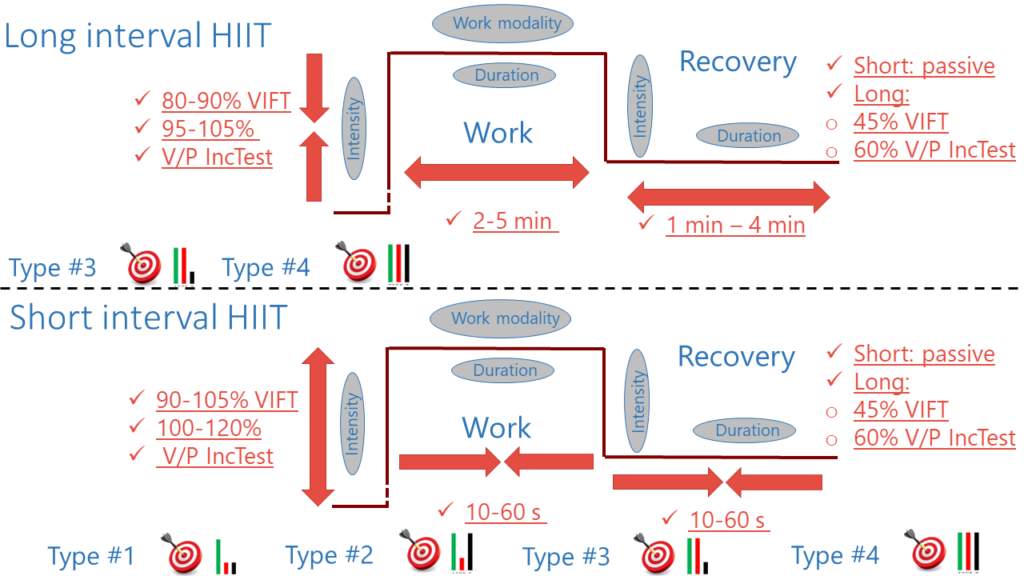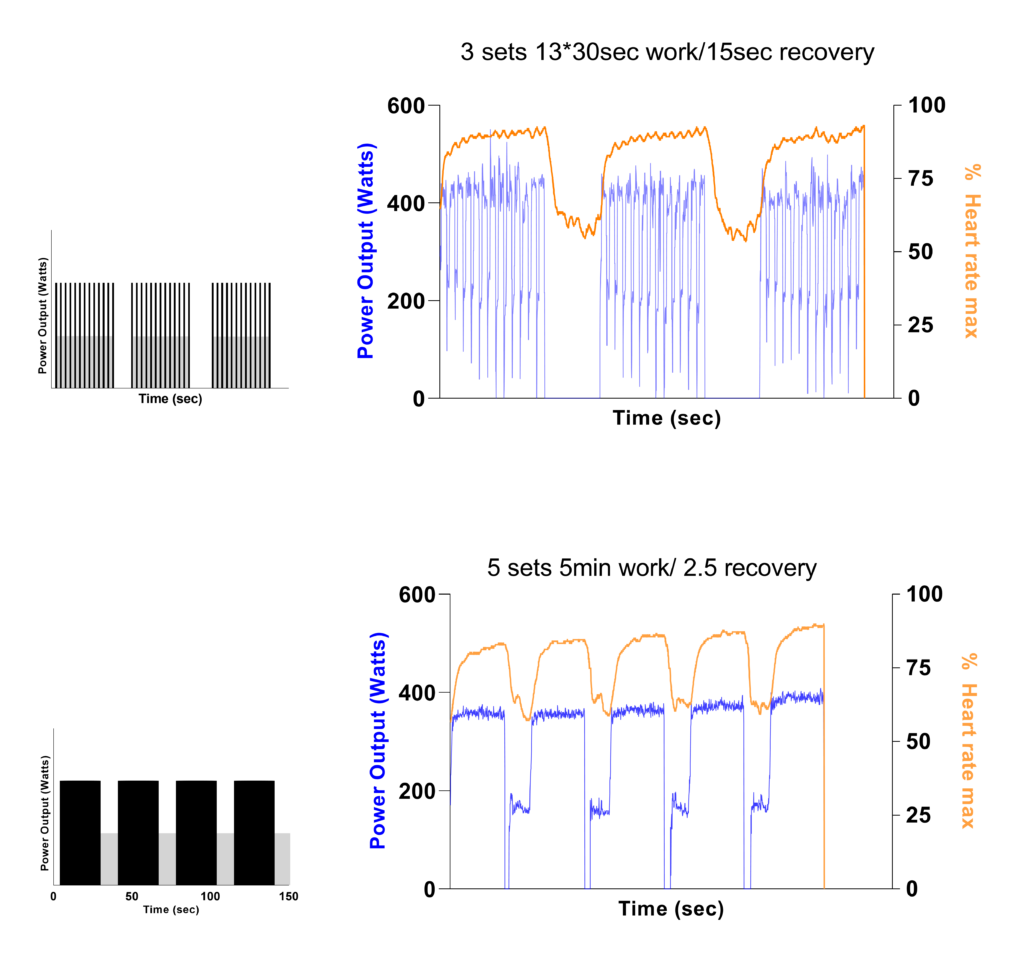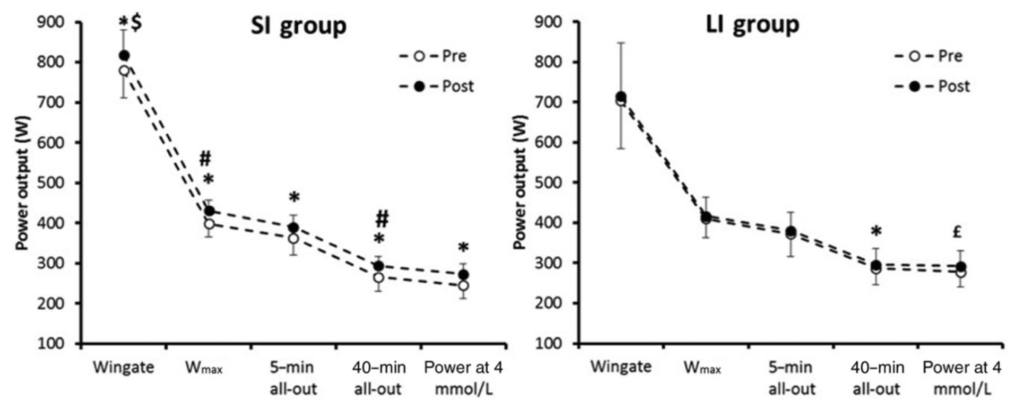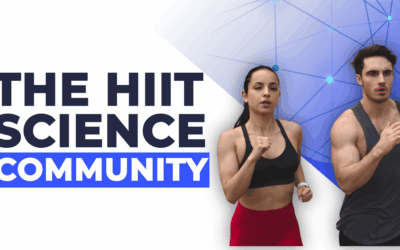Introduction
When fitness levels increase in athletes, the importance of maintaining a certain quality of training within the program increases.
However, the means by which to further enhance performance once one reaches the well-trained or elite level becomes more scarce (7).
At this level, additional time and effort spent on training may be limited. Therefore, maximizing the adaptive response out of each training session, «getting more bang for buck», becomes essential.
High-intensity interval training (HIIT) is considered a time-efficient way to improve aerobic fitness and endurance performance (5).
As previously described in HIIT Science (Ed.), HIIT can be organized in many different ways (figure 1). Two of these common formats include long intervals (LI) and short intervals (SI) with either active or passive recovery between work-intervals.
A typical format of both LI and SI used by coaches include HIIT sessions with a 2:1 ratio between work and relief phases (i.e. 5 min work, 2.5 min active recovery).

Figure 1: Short and long intervals and their recommended range of intensities, durations, and recovery characteristics.
What’s the key physiological difference between SI and LI?
When working continuously at intensities above lactate threshold for prolonged durations, as you do during LI, small disturbances of the homeostasis gradually leads to muscular fatigue, in time reducing your ability to contract during the interval bout.
In SI, homeostasis is quickly restored during the more frequent recovery periods (4). One of a number of important differences between SI and LI is explained by an interesting mechanism described in 1960 by Åstrand and colleagues (2). Myoglobin (the oxygen carrier inside the muscle cells), functions as an O2-store at the beginning of each short work-interval (2).
During the recovery periods of SI, myoglobin is reloaded with O2 (3), thereby reducing anaerobic glycolysis and lactate build-up in the following work-interval.
SI thereby exploits both a greater myoglobin reloading of O2, an increased oxygen extraction from repeated work and recovery of homeostasis during relief-periods, leading to a high average oxygen uptake and power output during many SI formats, which cannot be maintained during LI, due to the gradually increasing disturbance of homeostasis leading to fatigue.
Hypothetically, performing the SI compared to LI format, can allow athletes to work at a higher rate, consequently eliciting greater long-term endurance adaptations.
We therefore investigated the effect of performing SI compared to work duration- and effort-matched LI in well-trained and elite cyclists.
The research
In a series of studies, two different HIIT protocols were applied to examine the acute effects (1) and the chronic effects of performing 2-3 weekly sessions of SI or LI for 10 weeks in well-trained (10) and 3 weeks in elite cyclists (9).
The SI-protocol included 3 sets of 13 x 30 s work-intervals, interspersed by 15 s active recovery and the LI-protocol involved 4 x 5 min work-intervals, interspersed by 2.5 min active recovery (figure 2).
Both HIIT sessions were performed at the highest average power output possible across all work-intervals and were thus as evenly paced as possible.
During the active recovery, the power output was kept at 50% of the work-interval (e.g. 30 s work at 400 W, 15 s rest at 200 W). Both of these HIIT sessions would be considered as Type 4 responses in the HIIT Science context (Ed.).
 Figure 2: Schematic presentation of power output and heart rate in response to the short intervals (SI, 30/15 s) and the long intervals (LI, 5/2.5 min) used in three studies (1, 9, 10).
Figure 2: Schematic presentation of power output and heart rate in response to the short intervals (SI, 30/15 s) and the long intervals (LI, 5/2.5 min) used in three studies (1, 9, 10).
The results
Our studies confirmed that SI acutely led to a 14 ± 3% higher power output (table 1), 54 ± 76% longer working time above 90% of maximal oxygen uptake (SI: 853 ± 349 vs LI: 598 ± 200 s, p<0.05) and 153 ± 148% longer time above 90% peak heart rate (SI: 1373 ± 322 vs LI: 700 ± 341 s), p<0.05) during SI compared to LI.
Despite this, the elite cyclists experienced the same perceived exertion and reached similar blood lactate levels (1). In other words, they were able to work harder without experiencing it to be harder.
 Table 1: Average power output, blood lactate concentration ([BLa–]) and rating of perceived exertion (RPE) for each set and condition. SI; 3 sets of 13 x 30-s work intervals separated by 15-s active recovery, LI; 4 x 5-min work intervals separated by 2.5-min active recovery periods. § indicates significant different (P<0.05) to LI set, n = 8. Values are mean ± SD. Re-written from Almquist et al. (1).
Table 1: Average power output, blood lactate concentration ([BLa–]) and rating of perceived exertion (RPE) for each set and condition. SI; 3 sets of 13 x 30-s work intervals separated by 15-s active recovery, LI; 4 x 5-min work intervals separated by 2.5-min active recovery periods. § indicates significant different (P<0.05) to LI set, n = 8. Values are mean ± SD. Re-written from Almquist et al. (1).
When we looked at how cyclist’s adapted chronically to these intervals, we found that SI was more efficient at improving endurance performance (figure 3) and performance-determining factors such as maximal oxygen uptake (VO2max) and submaximal performance (threshold power) in both well-trained (10) and elite cyclists (9) compared to LI.

Figure 3: Power profiles in well-trained, competitive cyclists before (pre) and after the 10-wk intervention (post) in the short-interval training group (SI group; left panel) and the long-interval training group (LI group; right panel) performing SI or LI twice per week interspersed with low-intensity training. *Significantly larger than pre (P < 0.05). £Tendency toward larger than pre (P = 0.08). #The change from pre is larger than in LI (P < 0.05). $The change from pre tended to be larger than in LI (P < 0.10). Re-drawn from Rønnestad et al. (10).
The mechanisms
To better understand why the SI lead to superior performance adaptations, we investigated the acute muscular and hormonal responses to SI and LI in elite cyclists (1).Despite riding at a higher physiological strain, we observed similar acute muscular responses (mRNA) after SI and LI. However, the blood levels of testosterone and cortisol were higher when performing SI, which may facilitate recycling of damaged proteins and cellular structures, resulting in a greater re-building of proteins in the subsequent recovery phase (1). Over time, this might potentially increase training adaptations and together with a higher systemic stress, contribute to the observed greater performance improvements after weeks of training (9, 10).
Indeed, spending more time close to VO2max (6, 11) and at high exercise intensity (higher power output) (8) has been proposed to be the determining factors needed for improvements in both cardiorespiratory fitness and muscular adaptations.
However, the exact mechanisms driving these superior adaptations are still inconclusive and on the mechanistic level. Therefore we have so far only investigated the acute mRNA and hormonal responses. The translation of these acute measures is not always predictive of actual adaptations at the protein level and therefore needs further investigation.
How to incorporate short intervals into your training program
- SI intervals are easiest to perform during cycling or running, either outdoors on a consistent uphill gradient (ideally), or indoors on a smart trainer or treadmill.
- Establish what power output/speed you can maintain throughout the intervals. A rule of thumb could be to use the highest power output/speed you can obtain on a ~5 min all-out test for your work-interval power output/speed for SI prescription.
- Keep the intensity a bit lower in the beginning and adjust during the intervals reaching a high perceived exertion towards the end of the intervals.
- We have used 13 work intervals in our studies, but if you have a lower training status, you can start with fewer (e.g. 8) and steadily progress towards higher numbers.
Conclusion
Acutely, performing HIIT in a short interval-manner that included 30-s work-intervals with 15-s active recovery, compared to LI in well-trained and elite cyclists, lead to:
- Higher power output and longer working time above 90% of maximal oxygen uptake
- Equivalent levels of perceived exertion and blood lactate
- Higher blood levels of testosterone and cortisol
Our series of studies showed that performing short intervals compared to long intervals for 2-3 times per week for 3-10 weeks resulted in superior performance adaptations in both well-trained and elite cyclists.
About the authors


Nicki W. Almquist is a PhD-student in Exercise Physiology, currently finishing his PhD-thesis titled: “Optimizing endurance training in elite cyclists”.
Bent R. Rønnestad is a professor in Exercise Physiology.
Both are situated at the Section for Health and Exercise Physiology, Inland Norway University of Applied Sciences in Lillehammer, Norway.
References
- Almquist NW, Nygaard H, Vegge G, Hammarstrom D, Ellefsen S, and Ronnestad BR. Systemic and muscular responses to effort-matched short intervals and long intervals in elite cyclists. Scand J Med Sci Sports, 2020.
- Astrand I, Astrand PO, Christensen EH, and Hedman R. Myohemoglobin as an oxygen-store in man. Acta Physiol Scand 48: 454-460, 1960.
- Christmass MA, Dawson B, Passeretto P, and Arthur PG. A comparison of skeletal muscle oxygenation and fuel use in sustained continuous and intermittent exercise. Eur J Appl Physiol Occup Physiol 80: 423-435, 1999.
- Gunnarsson TP, Christensen PM, Thomassen M, Nielsen LR, and Bangsbo J. Effect of intensified training on muscle ion kinetics, fatigue development, and repeated short-term performance in endurance-trained cyclists. Am J Physiol Regul Integr Comp Physiol 305: R811-821, 2013.
- Laursen PB. Training for intense exercise performance: high-intensity or high-volume training? Scand J Med Sci Sports 20 Suppl 2: 1-10, 2010.
- Midgley AW and Mc Naughton LR. Time at or near VO2max during continuous and intermittent running. A review with special reference to considerations for the optimisation of training protocols to elicit the longest time at or near VO2max. J Sports Med Phys Fitness 46: 1-14, 2006.
- Psilander N, Wang L, Westergren J, Tonkonogi M, and Sahlin K. Mitochondrial gene expression in elite cyclists: effects of high-intensity interval exercise. Eur J Appl Physiol 110: 597-606, 2010.
- Ronnestad BR and Hansen J. Optimizing Interval Training at Power Output Associated With Peak Oxygen Uptake in Well-Trained Cyclists. J Strength Cond Res 30: 999-1006, 2016.
- Ronnestad BR, Hansen J, Nygaard H, and Lundby C. Superior performance improvements in elite cyclists following short intervals vs. effort-matched long intervals training. Scand J Med Sci Sports 30: 849–857, 2020.
- Ronnestad BR, Hansen J, Vegge G, Tonnessen E, and Slettalokken G. Short intervals induce superior training adaptations compared with long intervals in cyclists – an effort-matched approach. Scand J Med Sci Sports 25: 143-151, 2015.
- Wenger HA and Bell GJ. The interactions of intensity, frequency and duration of exercise training in altering cardiorespiratory fitness. Sports Med 3: 346-356, 1986.
Learn More
Dive deep into the world of HIIT science, gaining insights from proven methods and practical applications.
Whether you’re a coach or a scientist, understand how to harness the power of HIIT for maximizing athletic performance.






